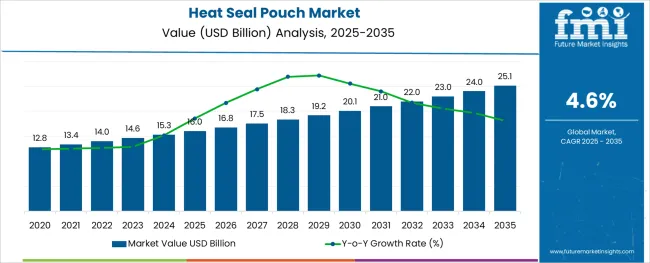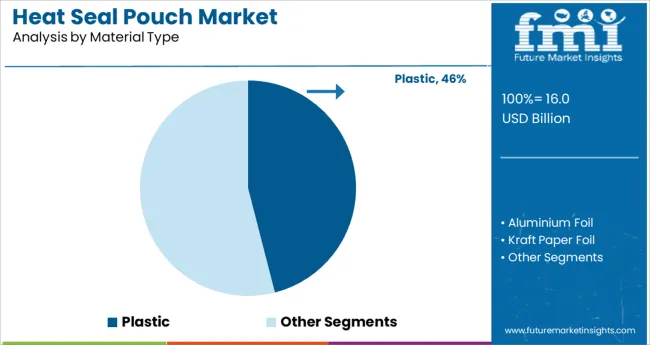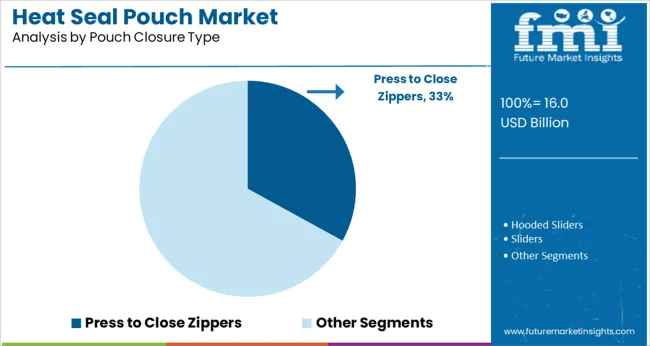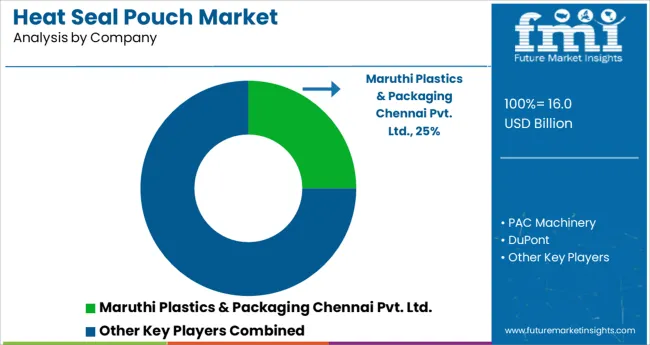The Heat Seal Pouch Market is estimated to be valued at USD 16.0 billion in 2025 and is projected to reach USD 25.1 billion by 2035, registering a compound annual growth rate (CAGR) of 4.6% over the forecast period.

The heat seal pouch market is witnessing steady growth, fueled by rising demand for durable, contamination-resistant, and aesthetically customizable flexible packaging solutions. Heat seal technology is gaining widespread adoption due to its ability to ensure airtight, leak-proof packaging that enhances product protection and shelf stability.
Increased focus on food safety, pharmaceutical hygiene, and consumer convenience is leading to the adoption of multi-layer barrier films and advanced sealing technologies. Brands are leveraging heat seal pouches for lightweighting strategies and environmental compliance, especially in applications that demand tamper evidence and recloseability.
The shift from rigid to flexible packaging, coupled with innovations in material science and printing, is enabling manufacturers to improve functionality while reducing packaging waste. Future growth is expected to be supported by e-commerce-ready pouch designs, increased integration of sustainable polymers, and regional expansion of automated filling and sealing systems.
The market is segmented by Material Type, Shape Type, Pouch Closure Type, Sealed Type, and End Use and region. By Material Type, the market is divided into Plastic, Aluminium Foil, Kraft Paper Foil, and Combination of These. In terms of Shape Type, the market is classified into K Seal, Round Bottom, and Corner Sealed.
Based on Pouch Closure Type, the market is segmented into Press to Close Zippers, Hooded Sliders, Sliders, Spouts, and Fitments. By Sealed Type, the market is divided into Bar Sealing, Ultrasonic Sealing, and Impulse Sealing. By End Use, the market is segmented into Food & Beverages, Personal Care, Health Care, Industrial Products, and Other Manufacturing Industries.
Regionally, the market is classified into North America, Latin America, Western Europe, Eastern Europe, Balkan & Baltic Countries, Russia & Belarus, Central Asia, East Asia, South Asia & Pacific, and the Middle East & Africa.

Plastic-based heat seal pouches are expected to hold 46.0% of the total market revenue in 2025, establishing them as the leading material segment. This leadership is being driven by plastic’s versatility, superior sealing properties, and compatibility with a broad range of product types and pouch formats. Plastic substrates offer excellent barrier protection against moisture, oxygen, and contaminants, making them ideal for perishable and sensitive goods.
Their lightweight nature and high tensile strength enhance packaging efficiency while reducing transportation and storage costs. Additionally, plastic materials can be easily thermoformed and laminated, allowing for multilayer constructions that combine product safety with marketing appeal.
The ability to integrate features such as zippers, spouts, and tear notches has further positioned plastic pouches as the preferred option in dynamic packaging environments. As manufacturers increasingly adopt recyclable and bio-based plastic alternatives, this segment is expected to maintain dominance through a balance of performance and sustainability.

K seal pouches are projected to account for 39.0% of the heat seal pouch market revenue in 2025, making them the leading pouch shape segment. This dominance is attributed to the K seal’s structural advantage, which reduces stress at the bottom corners and enhances load-bearing capacity during vertical storage and transport.
The K seal design provides superior durability under pressure, making it suitable for packaging liquids, granular materials, and heavier contents. Its compact shape supports better shelf arrangement and product presentation, contributing to increased retail appeal. The popularity of K seal pouches is also being driven by their compatibility with automated filling and sealing machines, which enhances operational efficiency across high-volume packaging lines. Their ability to integrate various closure systems and barrier materials has further reinforced adoption in food, pet care, and industrial sectors.
As durability and space optimization become key performance indicators in packaging, K seal designs are expected to retain a competitive edge.

Press to close zippers are expected to represent 33.0% of the total revenue share in the heat seal pouch market by 2025, establishing them as the leading pouch closure type. Their dominance is being driven by increasing consumer demand for resealable packaging that offers convenience, freshness retention, and tamper evidence. These zippers enhance product usability, enabling multiple uses without compromising the pouch’s seal integrity.
In industries like snacks, healthcare, and pet food, press to close systems have become standard due to their effectiveness in maintaining product hygiene and extending shelf life. From a manufacturing perspective, these closures are cost-effective and compatible with most heat seal films and automated pouch filling equipment.
Additionally, innovations in tactile feedback, ergonomic grip design, and child-resistant variants are expanding their usage across regulated and premium product categories. As consumer expectations for packaging functionality rise, press to close zippers continue to be favored for their simplicity, reusability, and reliability.
A pouch is a container which is used for carrying goods or products. The heat seal pouch is a type of pouch which does not allow the heat to escape into the outer environment. Heat seal pouches come with market friendly features such as zipper reclosure, tear notches, hang hole features, and attractive billboards for graphics.
The vendors are using sealed and microwaveable pouches for developing frozen food packaging designs which are easy to dispose of. The food sector is the largest end user of heat seal pouch market and is expected to occupy around 60% of total market share in the forecast period. Heat seal pouches are continuously gaining more importance in dry food packaging, bakery, poultry, frozen food, baby food, and others applications.
Growth in demand for heat seal pouch market is expected to grow strongly for several reasons. One of the significant factors contributing towards the growth of heat seal pouch is the growing demand for baby food, bakery products, confectionery, and frozen foods globally which are expected to drive the growth of this market in the coming years.
Another factor contributing towards the growth of heat seal pouch market is the rise in dual earning families and working professionals which have increased the consumption of processed food which in turn has increased the demand for convenient and high value added packaging solutions.
Moreover, the online ordering of grocery and food have also helped to increase the demand for packaged food which gives heat seal pouch market more scope for expansion. However, the high investment needed for the purchase of heat seal pouches for packaging is considered as the major threat to its market growth. The variation in raw material availability and energy prices could also have a negative effect on the growth of the heat seal pouch market.
On the basis of material type, the heat sea pouch market is segmented into plastic, aluminium foil, Kraft paper foil, or a combination of these. On the basis of shape, the heat seal pouch market is segmented into round bottom, K seal, and corner sealed.
On the basis of Pouch closure, the heat seal pouch market is segmented into a press to close zippers, hooded sliders, sliders, spouts, and fitments, etc. On the basis of sealed type, the heat seal pouch market is segmented into hot bar sealing, ultrasonic sealing and impulse sealing.
On the basis of end use, heat seal pouch market can be categorized into products of food & beverages, personal care, health care, industrial products, and other manufacturing industries. Further, health care segment can be sub categorized into medical practice, dental practice, veterinary, laboratory, and surgery. Food & beverages segment can be sub categorized into dairy, meat products, and confectionary products, ready to eat products and others.
The heat seal pouch market can be segmented into North America, Latin America, Europe, Asia Pacific, and Middle East & Africa. Europe is the largest revenue-generating region in the market of around 36% due to excessive demand for packaged food owing to a higher standard of living and high disposable income of people.
India and China are expected to show significant growth in heat seal pouch market volume share due to rise in the retail sector in these regions. Asia Pacific is the largest regional market for heat seal pouch, owing to high demand from end use industries such as food and beverages, personal care products, and packaging.

The following companies are the key players in the global bag heat seal pouches market: Maruthi Plastics & Packaging Chennai Pvt. Ltd., PAC Machinery, DuPont, Kamakshi Lamipack Pvt. Ltd., Shako Flexipack Pvt. Ltd., and Granton Cleanline.
The report is a compilation of first-hand information, qualitative and quantitative assessment by industry analysts, inputs from industry experts and industry participants across the value chain.
The report provides in-depth analysis of parent market trends, macro-economic indicators and governing factors along with market attractiveness as per segments. The report also maps the qualitative impact of various market factors on market segments and geographies.
The global heat seal pouch market is estimated to be valued at USD 16.0 billion in 2025.
It is projected to reach USD 25.1 billion by 2035.
The market is expected to grow at a 4.6% CAGR between 2025 and 2035.
The key product types are plastic, aluminium foil, kraft paper foil and combination of these.
k seal segment is expected to dominate with a 39.0% industry share in 2025.






Our Research Products

The "Full Research Suite" delivers actionable market intel, deep dives on markets or technologies, so clients act faster, cut risk, and unlock growth.

The Leaderboard benchmarks and ranks top vendors, classifying them as Established Leaders, Leading Challengers, or Disruptors & Challengers.

Locates where complements amplify value and substitutes erode it, forecasting net impact by horizon

We deliver granular, decision-grade intel: market sizing, 5-year forecasts, pricing, adoption, usage, revenue, and operational KPIs—plus competitor tracking, regulation, and value chains—across 60 countries broadly.

Spot the shifts before they hit your P&L. We track inflection points, adoption curves, pricing moves, and ecosystem plays to show where demand is heading, why it is changing, and what to do next across high-growth markets and disruptive tech

Real-time reads of user behavior. We track shifting priorities, perceptions of today’s and next-gen services, and provider experience, then pace how fast tech moves from trial to adoption, blending buyer, consumer, and channel inputs with social signals (#WhySwitch, #UX).

Partner with our analyst team to build a custom report designed around your business priorities. From analysing market trends to assessing competitors or crafting bespoke datasets, we tailor insights to your needs.
Supplier Intelligence
Discovery & Profiling
Capacity & Footprint
Performance & Risk
Compliance & Governance
Commercial Readiness
Who Supplies Whom
Scorecards & Shortlists
Playbooks & Docs
Category Intelligence
Definition & Scope
Demand & Use Cases
Cost Drivers
Market Structure
Supply Chain Map
Trade & Policy
Operating Norms
Deliverables
Buyer Intelligence
Account Basics
Spend & Scope
Procurement Model
Vendor Requirements
Terms & Policies
Entry Strategy
Pain Points & Triggers
Outputs
Pricing Analysis
Benchmarks
Trends
Should-Cost
Indexation
Landed Cost
Commercial Terms
Deliverables
Brand Analysis
Positioning & Value Prop
Share & Presence
Customer Evidence
Go-to-Market
Digital & Reputation
Compliance & Trust
KPIs & Gaps
Outputs
Full Research Suite comprises of:
Market outlook & trends analysis
Interviews & case studies
Strategic recommendations
Vendor profiles & capabilities analysis
5-year forecasts
8 regions and 60+ country-level data splits
Market segment data splits
12 months of continuous data updates
DELIVERED AS:
PDF EXCEL ONLINE
Heat Exchanger Inspection Service Market Size and Share Forecast Outlook 2025 to 2035
Heat-Treated NiTi Endodontic File Market Size and Share Forecast Outlook 2025 to 2035
Heated Sampling Composite Tube Market Size and Share Forecast Outlook 2025 to 2035
Heat Shrink Fitting Machines Market Size and Share Forecast Outlook 2025 to 2035
Heat Detachable Tape Market Size and Share Forecast Outlook 2025 to 2035
Heat Induction Cap Liner Market Size and Share Forecast Outlook 2025 to 2035
Heat Pump Market Size and Share Forecast Outlook 2025 to 2035
Heat Transfer Film Market Size and Share Forecast Outlook 2025 to 2035
Heater-Cooler Devices Market Size and Share Forecast Outlook 2025 to 2035
Heat Treating Market Size and Share Forecast Outlook 2025 to 2035
Heating Agents Market Size and Share Forecast Outlook 2025 to 2035
Heat Diffuser Market Size and Share Forecast Outlook 2025 to 2035
Heat Pump Market Analysis - Size, Share, and Forecast Outlook 2025 to 2035
Heat Pump Compressors Market Size and Share Forecast Outlook 2025 to 2035
Heat-Activated Beauty Masks Market Analysis - Size, Share, and Forecast Outlook 2025 to 2035
Heat Exchanger Market Size and Share Forecast Outlook 2025 to 2035
Heat Recovery System Generator Market Size and Share Forecast Outlook 2025 to 2035
Heat Shrink Tubes Market Size and Share Forecast Outlook 2025 to 2035
Heat Pump Laundry Dryer Rotary Compressors Market Size and Share Forecast Outlook 2025 to 2035
Heating and Cooling Market Size and Share Forecast Outlook 2025 to 2035

Thank you!
You will receive an email from our Business Development Manager. Please be sure to check your SPAM/JUNK folder too.
Chat With
MaRIA